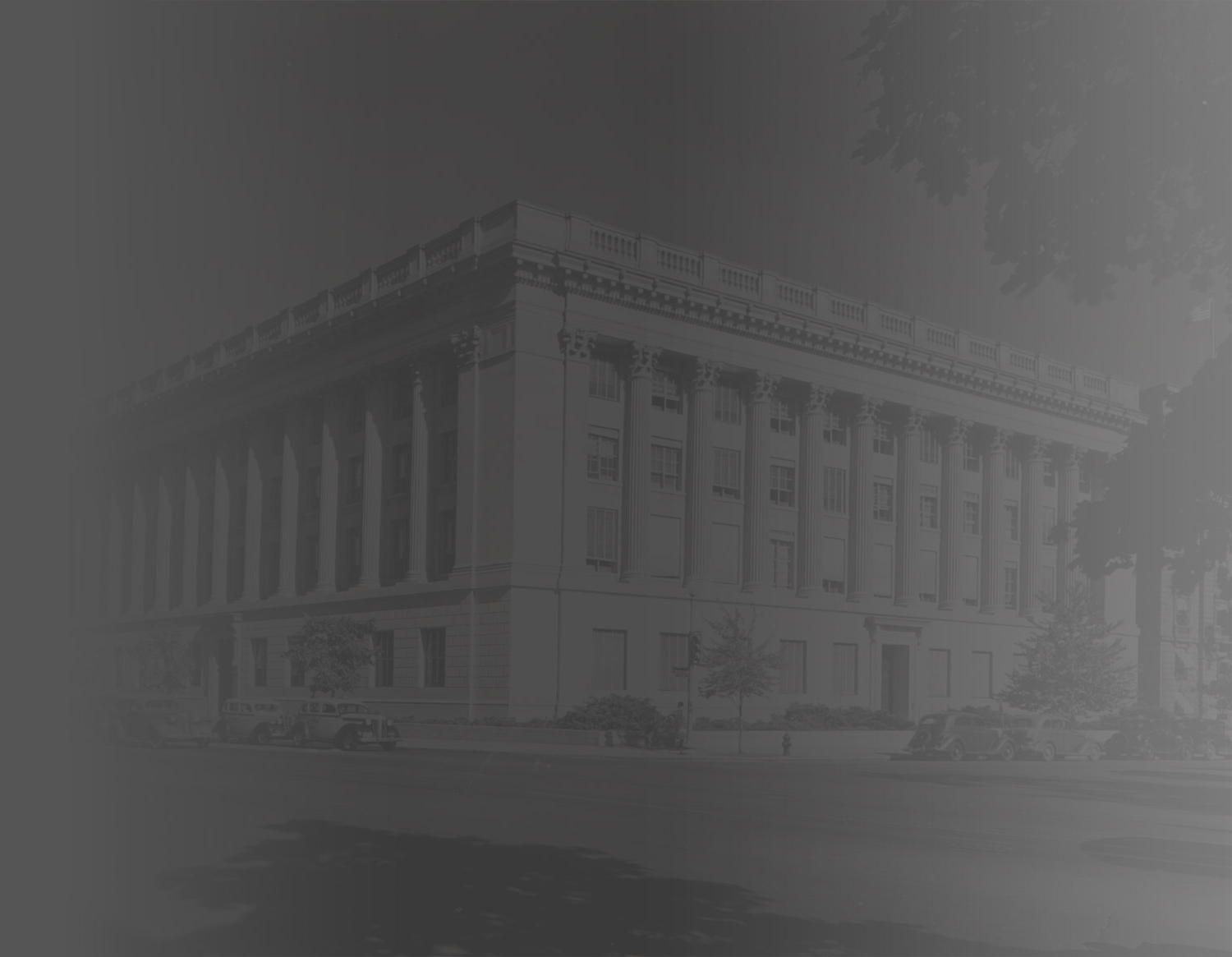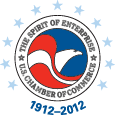

U.S. Chamber of Commerce

700 delegates from businesses, chambers, and associations throughout the country assemble at the request of U.S. President William Howard Taft. The President kept his remarks brief, but quite to the point:
“We want your assistance in carrying on the government in reference to those matters that affect the business and the business welfare of the country, and we do not wish to limit your discretion in that matter. We wish that your advice should be as free and unrestricted as possible, but we need your assistance and we ask for it.”

Harry A. Wheeler, vice president and director of the Union Trust Company, was unanimously elected temporary chairman of the U.S. Chamber.
He eventually became the first Chamber president.

The “unsinkable” Titanic sunk.

The U.S. Chamber gained its first member: Frederick, Maryland, board of trade.
The Chamber’s first Board of Directors was in session when the first membership application arrived. The Boston Chamber of Commerce eventually became the first to pay for its membership.
First edition of The Nation's Business was published.

Editor G. Grosvenor Dawe told its readers in the first editorial:
“The Nation’s Business will set forth periodically affirmative information and thought regarding our progress as a nation. Its columns will not be controversial. It will not touch partisan politics. It will assume that each public servant is well-intentioned and that he is entitled to that assumption until proved unworthy. The Nation’s Business will not muck-rake, denounce or defame.”

U.S. President William Howard Taft talked about the U.S. Chamber's potential influence.
“I am confident that with your marvelous growth, the sound principles upon which you have established your association, and the great opportunities that present themselves, the future of this organization will show it to be one of the real non-official factors in the progress of our country.”

The Chamber conducted the first referendum on whether there should be a “Plan for a National Budget” for the federal government.
President Harding signed legislation passed by Congress and strongly recommended by the Chamber that finally created a national budget system on June 10, 1921. Retired Army General Charles Dawes, the first federal Budget Director said this about the Chamber’s role, “The Chamber served as a focus for budget plans and came to be a radiant center of information about them. It submitted a program couched in business terms, and took the leading part in educating the public. The Chamber merits much credit for its effective campaign.”
General Dawes would later become Vice President of the United States (1925-1929).

The Chamber held its first annual meeting.
Rep. Carter Glass (D-VA) introduced legislation supported by the Chamber to establish the Federal Reserve System.
President Wilson signed into law the Federal Reserve Act of 1913, which was strongly supported by the Chamber.
The Chamber supported the Federal Reserve System, but declared against congressional tinkering with credit policies and price maintenance. On February 19, 1934 its membership urged that “immediate steps should be taken to produce a balance of expenditures and revenue by the fiscal year end.”

Harry Wheeler stepped down as the Chamber’s first president. John H. Fahey replaced him.
The Chamber strongly supported the creation of the Federal Trade Commission.
Legislation to create the Federal Trade Commission was enacted into law on September 26, 1914. The FTC began operations on March 16, 1915.
Baseball legend Babe Ruth made his major league debut with the Red Sox.


With the outbreak of World War I, the Chamber’s Executive Committee forwarded a resolution to the White House urging the federal government to provide risk insurance for American ships engaged in international trade.
In August 1914, Congress acted on the Chamber’s recommendation and approved legislation creating the Bureau of War Risk Insurance to offer such insurance at reasonable rates for two years.
Former President Theodore Roosevelt and U.S. President Woodrow Wilson publicly congratulated the Chamber on its efforts to bring the views of business on national issues to the attention of the government.
World War I moved quickly, both for the country and the Chamber. When hostilities began in Europe, American business read the news dispatches carefully. The national business federation proposed an international court or council of conciliation and recommended a conference of neutral nations to formulate rules for the protection of life and property from submarine attacks at sea.
Wilson told the delegates, “Seriously, the task of this body is to match all facts of business throughout the country and to see the vast and consistent pattern of it. That is the reason I think you are to be congratulated upon the fact that you cannot do this thing without common counsel. There isn’t any man that knows enough to comprehend the United States.”
The U.S. Chamber was incorporated under the laws of the District of Columbia.
President Wilson signed the Federal Aid Road Act of 1916.
The bill to improve highways and roads nationwide was based largely on Chamber policy proposals.
The Chamber continues to advocate for the need to maintain, modernize, and expand our nation's infrastructure supported infrastructure improvement through the Let's Rebuild America initiative.
Congress finally acted on the Chamber’s 1913 referendum recommendation to form a tariff commission.
The U.S. Tariff Commission was established November 8. The name was changed in 1974 to the U.S. International Trade Commission. The agency has broad powers to investigate trade issues and impartially enforce trade laws.
The Chamber’s War Service Committees helped keep a steady stream of supplies moving to the armed forces.

The U.S. Army’s First Division parading in New York City
To deal with the postwar economy, the Chamber called for convening the War Emergency and Reconstruction Congress in Atlantic City.
The 4,000 attendants of this nationwide event worked to obtain relief for businesses facing bankruptcy due to suspended war contracts. The Chamber worked closely with Congress to finance the $1.5 billion owed. Two months later, President Wilson signed legislation authorizing payments for many of these claims.
The Chamber’s seventh annual meeting was held in St. Louis with the delegates urging the Government to Eliminate Burdensome Regulations.
Also at the annual meeting, Wheeler proposed that the Chamber establish a permanent headquarters in Washington, D.C.
The U.S. Chamber’s Project on Regulatory Reform supports efforts to reform the regulatory process and make it more effective and accountable to the American people.

The amendment took effect on January 16, 1920. It banned the sale, manufacture, and transport of alcoholic beverages. This is the start of prohibition.
On December 5, 1933, the 21st amendment to the Constitution was ratified. It repealed the 18th Amendment – prohibition was over. Prohibition had a notable effect on the U.S. alcohol brewing industry. When prohibition ended, only half the breweries that previously existed reopened.

The number of Chamber business members (firms, corporations, and individuals) rose to 13,106.
The Transportation Act of 1920 returned control of America’s railroads to their private sector owners.
The Chamber played a major role in helping advance and improve this legislation, also known as the Esch-Cummins Act.

Women gain the right to vote.

U.S. Chamber's Institute for Organization Management Program was born.
Institute for Organization Management, the U.S. Chamber’s nonprofit, professional development program for chamber and association executives, is one of the nation’s oldest continuing adult education programs.
As recommended by the Chamber, The Revenue Act of 1921 was enacted.
The act reduced taxes and ended the wartime excess-profits tax.
The Chamber’s staff grew from 4 people in 1912 to 300 at the beginning of 1922.
Architect Cass Gilbert, the esteemed designer of the Supreme Court building, prepared the plans for the U.S. Chamber headquarters building.
The rich history of the Chamber building traces itself back to one of the 19th century’s most prominent politicians, Daniel Webster. In 1841, friends of Webster purchased a three-and-a-half-story home on the ground now occupied by the Chamber building.
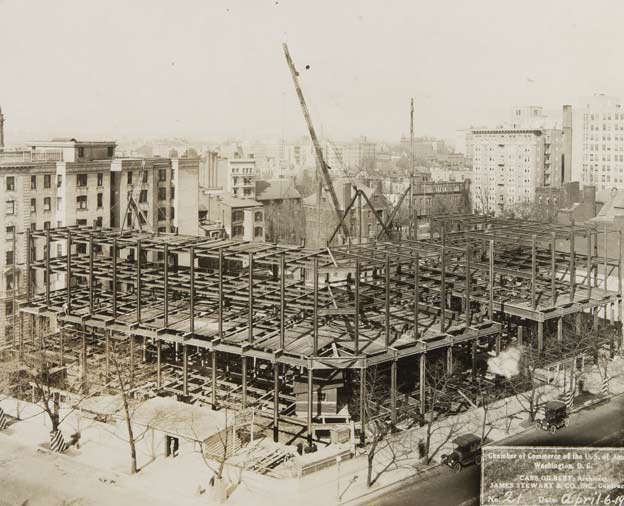
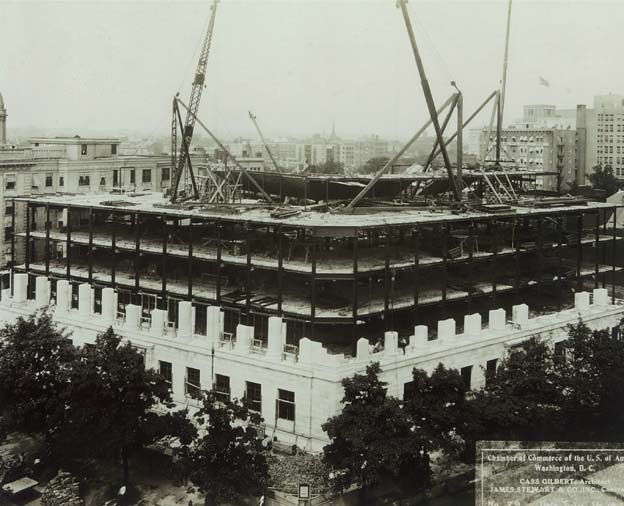
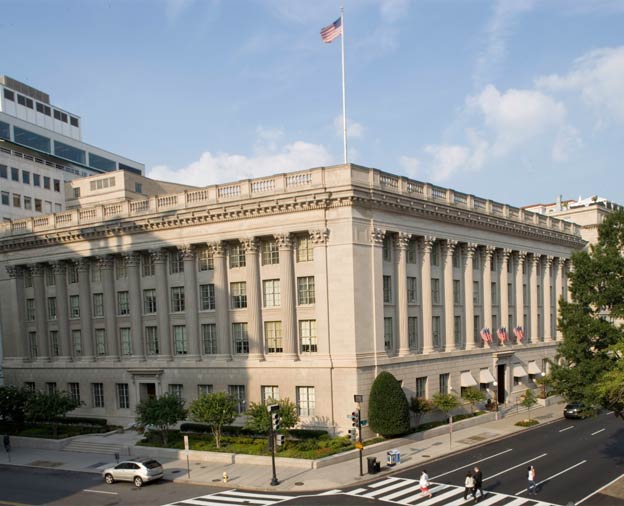
U.S. President Warren G. Harding introduced the first radio in the White House.
June 14, 1922—President Harding makes his first speech on the radio.
The first Macy’s Thanksgiving Day Parade was held in New York City.

It featured live animals from the
Central Park Zoo!
President Calvin Coolidge signed legislation strongly supported by the Chamber to contract for air mail services nationwide.
Fun fact: President Coolidge becomes the first U.S. President to have his inauguration broadcast on radio.
The first SATs—the Scholastic Aptitude Test—took place.
The SATs changed its name in 1990, becoming the Scholastic Assessment Test.
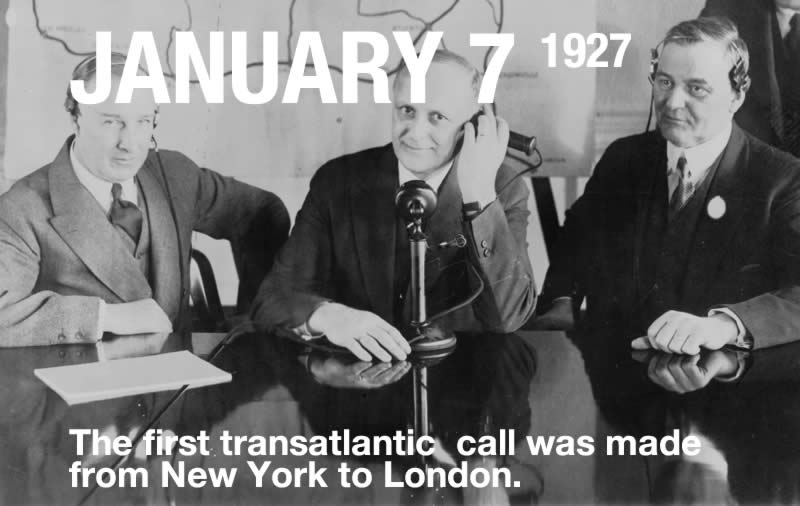
After an appeal from President Coolidge, the Chamber raised $1,750,000 for flood relief in Arkansas, Mississippi, and Louisiana.
The Chamber was praised by Coolidge, The New York Times, and The Philadelphia Public Ledger.
The Chamber’s 501(c) 3 affiliate, The Business Civic Leadership Center (BCLC), has maintained a long tradition of disaster relief and plays a positive role as the voice for businesses and their social and philanthropic interests.
Cartoon star Mickey Mouse appeared in Steamboat Willie, an animated short film produced by Walt Disney.
Walt Disney joined the Chamber as a member in 1922.

The Dow Jones dropped more than 20% in two days of hectic trading during the Wall Street Crash. This is the beginning of the Great Depression.
In the 1930s, the Chamber vigorously opposed the drift toward increased federal intervention and control and reinforced its traditional position that "the relation of government to industry is primarily that of preserving equality of opportunity for all."
The U.S. population reached 120 million.
Shortly after Black Tuesday, President Herbert Hoover appealed to the Chamber for help in rebuilding the nation after the stock market crashed.
More than 400 business leaders meet in the Chamber’s Hall of Flags to discuss the state of the economy with President Hoover. After the meeting, the Chamber formed the Business Survey Conference Committee of 170 business leaders from all sectors to act as an advisary body to President Hoover and the Commerce Department.


Aviator Amelia Earhart became the first woman to successfully pilot an aircraft solo across the Atlantic Ocean.
She flew a Lockheed Vega 5B. Lockheed Martin became a Chamber member in 1997.
Franklin Delano Roosevelt became president of the United States.
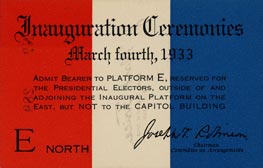
The new vice president was John Nance Garner, the former House Speaker. This was the last time a president and vice president were inaugurated in March. Roosevelt appoints Francis Perkins as Secretary of Labor, the first woman to serve in the Cabinet.
The New Deal began.
The Chamber voted to approve U.S. President Roosevelt’s banking and budget measures.
Congress passed and the president signed the Securities Exchange Act creating the Securities and Exchange Commission (SEC).
The SEC would license stock exchanges, monitor stock and securities transactions, and determine the legality of speculative and other market practices. The Chamber worked hard to improve the bill.
The Chamber strongly opposed legislation by Sen. Robert Wagner (D-NY) that would strengthen the ability of labor unions to organize workers.
The Chamber found that the proposed National Labor Relations Board (NLRB) would lead to “partisan” decisions. The Chamber called the board’s proposed methods of operations unusual, unethical, illegal and, if enacted into law, “unconstitutional.”
First canned beer goes on sale.
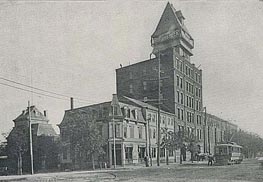
In partnership with the American Can Company, the Gottfried Krueger Brewing Company delivered 2,000 cans of Krueger’s Finest Beer and Krueger’s Cream Ale to faithful Krueger drinkers in Richmond, Virginia. Today, canned beer accounts for approximately half of the $20 billion U.S. beer industry.
Over President Roosevelt’s veto and with strong support from the Chamber, Congress enacted the Revenue Act of 1938.
This reduced corporate income taxes for the purpose of stimulating the economy.
President Roosevelt signed into law the Wheeler-Truman Transportation Act of 1940, which was supported by the Chamber.
The law was intended to remove obstacles to railroad consolidation and permitted carriers to adjust their capital equipment and services to existing conditions.
President Roosevelt was elected in an unprecedented third term as president.
Roosevelt was also elected to a fourth term in 1944, but he died less than four months after his inauguration.


In the midst of World War II, U.S. defense and war agencies turned to the Chamber for advice and assistance in recruiting, procurement processes, local support, industrial scrap, and various other war time needs.
Chamber President Eric Johnston told a business audience in Baltimore that the responsibility for continuing the American enterprise system after the war rested largely with businessmen.
He repeated his view that business must provide employment for the majority of the nation’s postwar workers.
The world's largest office building, the Pentagon was dedicated in Arlington, Virginia.
Did you know? Construction on the Pentagon began on September 11, 1941, 60 years to the day before the 9/11 terrorist attacks.
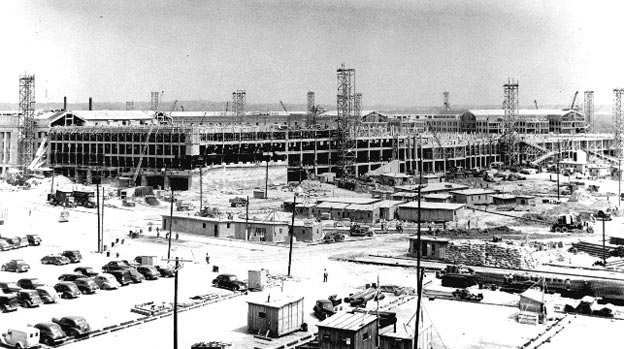
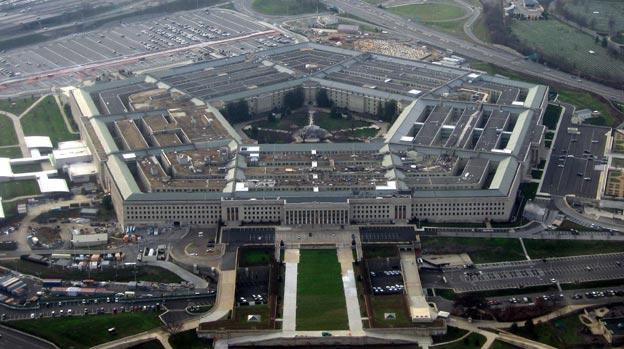
President Roosevelt commended the U.S. Chamber for its contributions to the war effort.
“Only by teamwork on the part of labor and management could we have reached the present high peak of production so essential to the successful prosecution of the war. … Members of the United States Chamber of Commerce may well be proud of the contribution they have made under your able leadership. I have had the opportunity to know of and cause to appreciate that leadership. American business is meeting the challenge of war and meeting it in a way that brings comfort to our people, and fear to our enemies.”
Women are appointed to Chamber committees.
World Event: The Cold War era began.
The Chamber was one of 45 organizations asked by the State Department to name representatives to serve as consultants to the U.S. delegation to the United Nations conference in San Francisco.
The task of the conference was to form the United Nations organization, which would replace the League of Nations. The first meeting was held January 1946 in London.
U.S. Atomic Energy Commission (AEC) was established.
At the 1953 annual meeting, the Chamber would adopt a policy urging cooperation by the Atomic Energy Commission (AEC) with private enterprise and opposing the entry of the federal government directly into the commercial production of atomic energy.
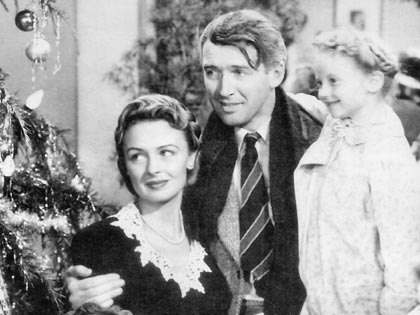
It's a Wonderful Life was released.
It's a Wonderful Life was nominated for five Oscars without winning any. The American Film Institute recognizes the film as one of the 100 best American films ever made and the number one on its list of the most inspirational American films of all time.
American Chambers of Commerce (AmChams) abroad was adopted by the board of directors of the Chamber of Commerce of the United States.
AmChams advance the interests of American business overseas. They are voluntary associations of American companies and individuals doing business in a particular country, as well as firms and individuals of that country who operate in the United States.
There are 115 accredited AmChams in 102 counties around the world today.
Fun Facts: AmCham France was founded by 11 U.S. businessmen in Paris on June 28, 1894, making it the oldest U.S. business association overseas. AmCham Philippines was initiated in 1902, shortly after the American-Spanish War.
The Truman administration, supported by the Chamber, unveiled the European Recovery Plan known as the Marshall Plan.
The plan was later enacted into law and funded by Congress on April 2, 1948. Its purpose was to aid European recovery after the massive destruction caused by World War II. The Marshall Plan has often been cited as one of the most significant and successful U.S. foreign policy initiatives.

Seventeen district managers are appointed to help six division managers who are stationed around the country to drive the pro-business agenda at the local and state levels.
The U.S. Chamber was accorded consultative status to the United Nations. With this, the Chamber's International Division was born.
The Chamber’s International Division improves the ability of U.S. businesses to compete in the global marketplace by providing its members valuable resources and cutting-edge events.
The Small Business Administration (SBA) was created by President Dwight D. Eisenhower.
SBA is an independent federal agency charged with aiding, counseling, and protecting the interests of American small businesses.

World Event: School segregation in the United States was declared unconstitutional by the Supreme Court in the Brown v. Board of Education case.
The Chamber unveiled It's Everybody’s Business, a best-selling animated Technicolor film on the American competitive enterprise system.
Made in Hollywood by John Sutherland Productions in cooperation with the DuPont Company, the film quickly won the Freedom Foundation’s top film award.
The Chamber’s 43rd annual meeting was held in Washington, D.C., and attended by a former, present, and future president of the United States.
President Eisenhower addressed the opening session, former President Herbert Hoover spoke at one of the luncheons, and Vice President Richard Nixon attended the Chamber’s open house.
The Chamber released the motion picture, People, Products and Progress: 1975.
The film portrayed advances that were likely to emerge in the coming 20 years based on the current work of scientists, engineers, research laboratories, and the drawing boards of industry. This film was a good example of the Chamber’s “look-ahead” activities in the mid-1950s.

Rosa Louise McCauley Parks refused to give up her seat to a white passenger on the bus driver’s demand.
Parks was an African American civil rights activist whom Congress dubbed the "Mother of the Modern-Day American Civil Rights Movement".
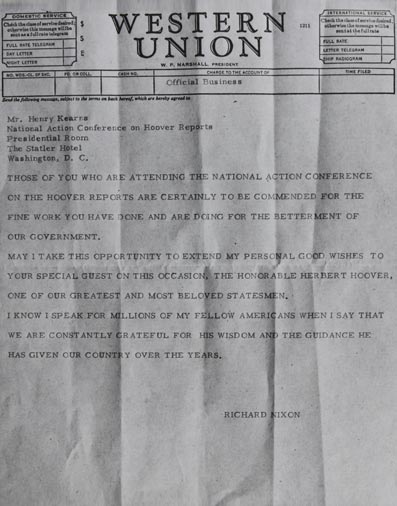
Top-level business executives gathered in the Chamber’s Hall of Flags for the Chamber-sponsored National Action Conference on the Hoover commission’s reports to reform the federal government.
The U.S Chamber created a government operations and expenditures program.
The program was established to study and analyze the federal budget and the growing national debt.
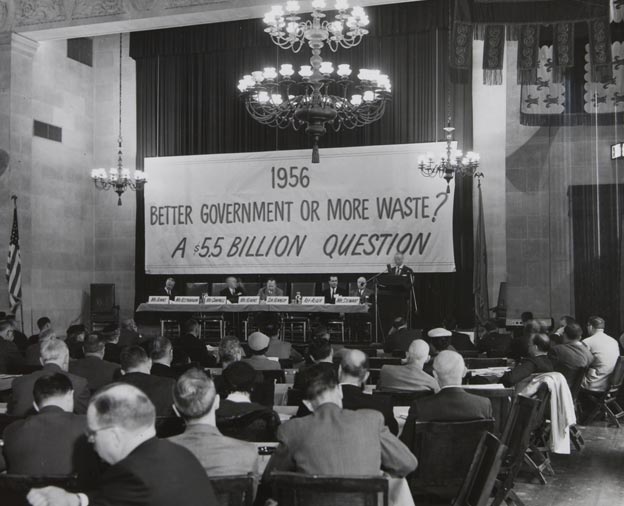
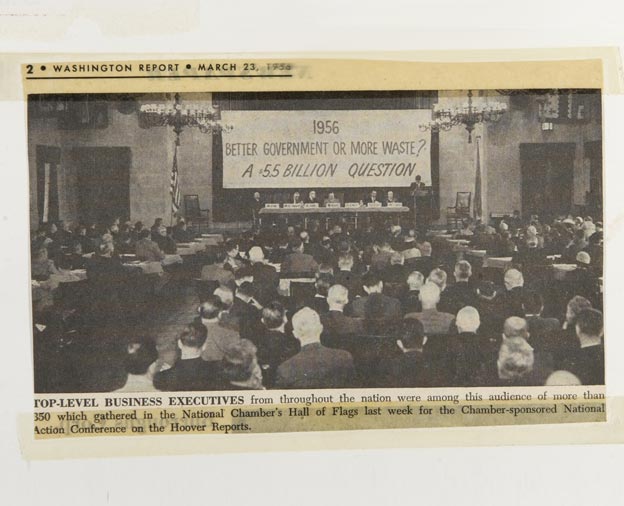
President Eisenhower and Vice President Richard Nixon easily won reelection.
This would be the last presidential election with only 48 states. In 1959, two new states, Alaska and Hawaii, would be joining the union. This would also be the last election in which one candidate (President Eisenhower) was born in the 19th century.

Vice President Richard Nixon and Sen. John F. Kennedy (D-MA) address delegates at the Chamber’s 45th annual meeting.

The first car sold is the Toyopet Crown. Toyota Motor Company was founded in 1937 and became a Chamber member in 1977.

Surprise visitor, President Eisenhower gave the concluding remarks at the Chamber’s 46th annual meeting.
His off-the-cuff remarks applauded the Chamber for its efforts in the area of defense reorganization.
The Chamber building expanded.
With the Chamber’s increasing number of projects, programs, and activities, more floors were added to the rear section of the building. A new basement under the courtyard increased office space by 50%.



"You have established in this country a very enviable reputation for making recommendations to the Government or for stating propositions before our people that are based upon principle and not expedience."

The Peace Corps was established by U.S. President John F. Kennedy.
Photograph by Rowland Scherman, Peace Corps, in the John F. Kennedy Presidential Library and Museum, Boston.
President Kennedy sent 400 Green Beret special advisors to Vietnam to train South Vietnamese soldiers in methods of counter-insurgency. The number of U.S. military personnel would triple by year’s end.


In honor of its 50th anniversary, President Kennedy spoke to the Chamber about the importance of the free enterprise system.
"The foundation of the Chamber in April of 1912 marked a turning point in the relations between government and business, and there are some who say that the events of April of 1962 have also marked a turning point in the relations between government and business. I hope that this is so, in the sense that both sides will have new emphasis upon the obligation to understand each other’s problems and attitudes.
Never in the 50-year history of the Chamber of Commerce has its dedication to a vigorous economy been more in the national and international interest than it is today. This administration, I assure you, shares your concern about the cost-profit squeeze on American business. We want prosperity and in a free enterprise system there can be no prosperity without profit. We want a growing economy, and there can be no growth without the investment that is inspired and financed by profit."

Reverend Martin Luther King Jr. delivered his historic 17-minute "I have a dream" speech on the steps of the Lincoln Memorial.
Martin Luther King Jr. was assassinated in Memphis, Tennessee, on April 4, 1968.

At 12:30 p.m. CST in Dallas, President Kennedy was assassinated.
After his funeral in Washington, D.C., on November 25, Kennedy was buried with full military honors in Arlington National Cemetery. The Chamber’s board of directors was in session when the news arrived that President Kennedy had been killed.

The new law, one of the most sweeping civil rights bills ever enacted, prohibited racial discrimination in employment, places of public accommodation, publicly owned facilities, union membership, and federally funded programs.
The Chamber’s Accreditation program, which defines standards of excellence in chamber planning and performance and shows chambers how they can reach and maintain these standards, was established.

It also helps chambers measure achievement while recognizing and encouraging chamber members and staff who meet high standards of operation and who contribute effectively to the good of their chambers and communities.
Washington, D.C. residents were able to vote in a presidential election for the first time.
The Chamber addressed poverty in America.

In response to the Great Society reform program, the U.S. Chamber organized a task force to study the problem of poverty. The group consisted of 100 executives from major corporations, as well as a host of academics, economists, sociologists, and other experts.
The new federal Department of Transportation (DOT) was established.
The Chamber strongly supported the creation of this department to coordinate all federal transportation programs.

Ronald Reagan entered politics becoming governor of California.
The Chamber created the National Chamber Foundation (NCF), an affiliated corporation to analyze critical economic and policy issues facing the nation.

Today, NCF’s resources and programs focus on three goals: examine emerging business issues, drive public debate, and inform business and government leaders.
McGraw Hill Book Company published and released The Business of Business: Private Enterprise and Public Affairs, which contained former Chamber President Mike Wright’s far-ranging speeches.

Myron A. “Mike” Wright would later become president, chairman, and CEO of Exxon in the 1970s.
The Chamber led the effort to get Congress to pass legislation celebrating federal holidays on Mondays.
As passed, the legislation applied only to federal and District of Columbia employees. It would still be necessary for the states to enact their own individual uniform Monday holiday laws. Within a year, 36 states adopted their own versions, with more to follow.
With strong support from the Chamber to reduce the growing budget deficit and balance of payments deficit, President Johnson signed into law the Revenue and Expenditures Control Act of 1968 to help pay for the war in Vietnam.
The measure imposed a temporary 10% income tax surcharge on both individuals and corporations until June 30, 1969. The surcharge was estimated to collect $4.5 billion in higher taxes annually. The legislation also cut federal spending by $6 billion.

U.S. President Richard Nixon gave closing remarks at the Chamber’s 57th annual meeting, recalling that except for President Lyndon Johnson, he was the only person who had addressed the Chamber’s annual meeting as a congressman, senator, vice president, and finally, president.
He referred humorously to his loss in 1960, he said, "I am here a little later than I expected."

The United States puts a man on the moon.
The historic and televised Apollo 11 Saturn rocket mission to the moon was successful and watched by many millions of people throughout the world. As Apollo capsule pilot Michael Collins circled above the moon, astronauts Neil A. Armstrong and Edwin E. “Buzz” Aldrin Jr. landed on the surface in the lunar lander.
The Chamber intensified its focus on the nation’s urban problems, especially crime, and how it could help its members deal with these growing challenges.
President Nixon signed into law the Postal Reorganization Act of 1970, which was strongly supported by the Chamber.
The new law abolished the U.S. Post Office Department and created the U.S. Postal Service, an independent agency.
Chamber members voted overwhelmingly to support reform of the nation’s health care system.
The economy grew slightly in the ‘70s. But inflation was becoming a serious problem and rising health care costs were a growing concern.
President Nixon’s Special Message to the Congress on Health Care:
"An all-directions reform of our health care system—so that every citizen will be able to get quality health
care at reasonable cost regardless of income and regardless of area of residence—remains an item of highest
priority on my unfinished agenda for America in the 1970s."
The issue of health care would continue to grow in importance for the nation and the Chamber over time.
The 26th Amendment to the Constitution was ratified, granting Americans 18 years and older the right to vote.
President Nixon certified the ratification on July 25.

Chamber board members endorsed President Nixon’s actions that were taken under the authority of the Economic Stabilization Act of 1970.
This law authorized the President to stabilize prices, rents, wages, salaries, interest rates, dividends, and similar transfers.
The Economic Stabilization Act of 1970 was not a public favorite at first, but the end result was that it was a success.

Gov. Ronald Reagan (R-CA), a future U.S. president, spoke at the Chamber’s 60th annual meeting to appeal for a better relationship between business and government.
Reagan said that politics was too important to leave to the politicians. He said, “The special genius and capacity for problem solving of business should be shared with government at all levels.”

The first episode of the popular TV series M*A*S*H* premiered on CBS.
Fun fact: Wayne Rogers (top, middle of photo), a star of the show known as Trapper John McIntyre, was a speaker at America’s Small Business Summit 2011, the Chamber’s largest small business member event.

Dr. Martin Cooper of Motorola invented the mobile phone.
Chamber Executive Vice President Arch Booth commented on the unfolding Watergate scandal in an open letter to businessmen.
"We in the business community need to maintain a wholesome perspective and positive attitude with respect to the Washington revelations. They are shocking, of course. Much is being said about the effect on the ability of the President to govern effectively, and the slowing down of government machinery. These are valid concerns...
We in business must rededicate ourselves to participate constructively in the political process. With respect to persons hit by the scandals, all of us must determine to keep an open mind until all of the evidence is in."

The Arab oil embargo caused rapidly rising fuel prices and long lines at gasoline stations throughout the nation.
The Chamber recommended an increase in the leasing of offshore areas for oil and gas exploration, expansion of domestic markets for coal, construction of the Trans Alaska Pipeline, enactment of legislation expanding the mining of our vast coal reserves, relief from harsh and restrictive mine-safety standards, and reconciling air-quality requirements with the need for expanding domestic energy supplies. On November 16, 1974, Congress approved legislation authorizing the construction of the Trans Alaska Pipeline.

U.S. Chamber launched Economics for Young Americans.
The U.S. Chamber established this program to teach young people about the importance of preserving and advancing the free enterprise system. The Chamber’s commitment to educating Americans on the principles of free enterprise continues today with the Campaign for Free Enterprise.
President Nixon signed into law the Congressional Budget Act of 1974.
The Chamber worked hard for the enactment of this legislation.

The Kenbak-1, the first personal computer, was designed and invented by John Blankenbaker of Kenbak Corporation.
Congress passed the foreign trade bill that conferred most-favored-nation status on the Soviet Union and other communist nations. The Chamber supported these efforts to expand trade opportunities for American business.
U.S. President Gerald Ford signed the Trade Act of 1974, which was supported by the Chamber.

President Ford spoke at the Chamber’s 63rd annual meeting and saluted outgoing Chamber President Arch Booth.
His address was interrupted 13 times by vigorous and sustained applause.

The Chamber distributed and promoted a booklet titled Introducing the Chamber of Commerce of the United States.
The foreword by Chamber President Richard Lesher began, “The people of the federation known as the Chamber of Commerce of the United States are dedicated to the advancement of human progress through an economic, political, and social system based on individual freedom, incentive, initiative, and opportunity. In short, we are committed to human progress through private enterprise, which is in complete accord with the intentions and beliefs expressed by this Nation’s founding fathers.”
Note: The word “responsibility” was soon added to the Chamber’s mission statement after “incentive, initiative, and opportunity.”


President Ford signed into law the Overseas Voting Rights Act of 1975, which was strongly supported by the Chamber.
The law gave the right to an absentee ballot to 750,000 Americans working overseas who were technically prevented from voting by state laws.
The Small Business Council was established to better serve the specialized needs of the Chamber’s small business membership. At the time, small business represented 95% of all businesses in the nation. Today, it represents 97%.
Today, the Council on Small Business is the U.S. Chamber's principal policy committee and action group representing the issues of concern to small business. In addition to formulating small business policy, the council assists small business members in creating effective grass roots actions and strategies on legislative, regulatory and international initiatives.

Nation’s Business had a two-page advertisement promoting the Chamber’s newly released film The American Album.
The 20-minute film was narrated by actor James Stewart and produced by Hanna-Barbera of Hollywood fame. It dramatically emphasized the role that freedom of enterprise played in building the United States during our first 200 years of history.

The nation celebrated 200 years of independence.
Bicentennial parades and ceremonies took place nationwide. New York City played host to Operation Sail as the ships of 30 nations navigated the harbor, including 225 tall-masted sailing ships.
In the nation’s capital, Chamber officers and staff and their families watched the spectacular fireworks and fighter jets flying down Pennsylvania Avenue from the roof of the Chamber Building.
Originally recommended by Lewis Powell Jr. in the Powell Memorandum in 1971, the National Chamber Litigation Center (NCLC) was created and launched by the Chamber.

Its mission was to better represent business in key court cases and administrative law proceedings. NCLC was the Chamber’s business-oriented public interest law organization that would turn out to be a true innovation and highly successful. As of today, NCLC has participated in over 1,800 cases addressing a wide range of legal issues at every level of the judicial system.
"The chamber’s litigation unit, set up in 1977, may be second only to the solicitor general’s office in its influence at the Supreme Court." Bloomberg, "Obama 10th Justice Kagan Subverts Supreme Court Business Tilt," January 11, 2010
In response to President Jimmy Carter’s request, the Chamber submitted a plan to ease the federal paperwork burden that cost American business tens of billions of dollars each year.
The Chamber proposed that the Office of Management and Budget (OMB) be broken up into two subagencies. The Executive Budget Office would be responsible for preparing and monitoring the administration’s annual federal budget submitted to Congress. The Executive Management Office would assist the president in managing the departments and agencies and in controlling paperwork by serving as a clearinghouse for all new federal reporting requirements.
Star Wars, an American epic space opera film series, created by George Lucas, was released by 20th Century Fox.
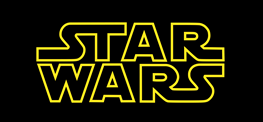
Star Wars became a worldwide pop culture phenomenon, followed by two sequels and three prequels, released at three-year intervals.

Following the historic signing of a peace treaty between Egypt and Israel, the leaders of both nations used Chamber forums to speak to American business leaders.
Chamber President Richard Lesher welcomed Egyptian President Anwar El-Sadat to the Chamber Building. President Carter introduced the Egyptian leader to the business audience. President Sadat appealed to U.S. businesses to invest in Egypt. He said, “We have land, water, resources. Come and be my partner. ... I promise you there will be no red tape.”
At a luncheon meeting in New York sponsored by the Israel-U.S. Business Council, Prime Minister Menachem Begin of Israel encouraged American businessmen to invest in his country. He said, “Free Enterprise is the philosophy of our government.”
With strong backing from the Chamber, President Carter proclaimed this week as “Small Business Week, 1979.”
The proclamation, which was printed in Nation’s Business said, “Small business has been the economic backbone of American life since the earliest colonial days. ... There are 13.9 million businesses in the United States today, and 13.4 million are small, including nearly three million farms. Together they provide employment for over half the business labor force and account for more than 48% of the gross business product. ... Meetings are currently being held in every State of the Union in preparation for the first White House Conference on Small Business which I have called for in January 1980.”
“It’s Your Business,” the Chamber’s weekly debate program premiered on 73 television stations.
The debate program featured Chamber president Richard Lesher as a permanent panelist. Topics generally were Chamber legislative or regulatory issues. The initial moderator was Karna Small.
Actors in colonial dress on the steps of the Capitol were completing the filming of a 28-minute musical for the Chamber called “Let’s Get It Back, America.”
The four singing actors were played the roles of George Washington, Benjamin Franklin, James Madison, and Alexander Hamilton. The plot of the film was how these founding fathers would react to the America of 1980 if they came back to see how the nation had progressed.
Here are samples of the lyrics:
“Let’s Get It Back, America
The spirit that we knew
The pride of self-achievement
The voice that says ‘can do.’
Let’s Ring the Bell, America
Sound off for liberty
Proclaim what we believe in,
Good old democracy.”
A presidential proclamation and joint resolution of Congress proclaimed October 3 as American Enterprise Day.
The Chamber achieved this designation and launched a nationwide public service advertisement campaign to emphasize the advantages and opportunities that the nation experienced because of our free enterprise system.
An excerpt from President Carter’s proclamation: Now, Therefore, I, Jimmy Carter, President of the United States of America, do hereby proclaim October 3, 1980, as American Enterprise Day, and I urge business, labor, agricultural, educational, professional, consumer and civic groups, as well as the people of the United States generally, to observe American Enterprise Day with appropriate activities that promote appreciation of the American free enterprise system and its benefits.
The Let's Rebuild America (LRA) initiative is launched.
Through the LRA initiative, the U.S. Chamber advocates for the need to maintain, modernize, and expand America’s infrastructure. This initiative focuses on driving public awareness, expanding research, and building strong political action.
Today, the U.S. Chamber is leading the charge to modernize and expand our nation’s transportation, telecommunications, energy, and water networks. Without proper investment and attention to our infrastructure systems, the nation’s economic stability, potential for job growth, and global competitiveness are at risk.
Strongly supported by the Chamber, President Ronald Reagan signed into law the Economic Recovery and Tax Act (ERTA), also known as the Kemp-Roth tax cuts bill.
This measure cut taxes across the board by decreasing marginal income tax rates by 23% over 3 years. At the time, it was the largest tax cut in history providing $748.8 billion in tax relief to individuals and corporations. The Chamber devoted its resources to building support in Congress for the enactment of this bill, a key component of President Reagan’s economic program.

President Reagan addressed the Chamber’s 70th annual meeting.
“Well, this is a happy day, and I am honored to be with you. You’ve earned the great respect of individuals and organizations all across this country and, may I say, a warm spot in my heart. The Chamber is celebrating an important milestone this week, your 70th anniversary. I remember the day you started. (Laughter) And like good wine, you’ve grown better, not older. The membership of the Chamber of Commerce of the United States is the only thing that’s grown faster than the Federal Government—thank heaven!”
Congress passed the Job Training Partnership Act (JTPA), which was strongly supported by the Chamber and the National Alliance of Business.
This legislation, signed into law by President Reagan, was the successor to theComprehensive Employment and Training Act (CETA) of 1973. The new law provided for the nationwide establishment of local education-for-employment centers to train youths aged 14 to 21 for entry-level employment.
The Chamber called the act “a sensible and workable law” and said its success “will depend on the degree to which the business community makes a commitment to leadership.”
The first private business advocate satellite television network in history, BizNet, the American Business Network, covered the Chamber’s annual meeting.

BizNet was a communications system designed to influence legislation and rally support for American business objectives.
Unemployment rose to 12 million in the United States, the highest figure since 1941.
The State Department Authorization Act of 1983 created the National Endowment for Democracy and the Center for International Private Enterprise (CIPE), a U.S. Chamber affiliate.

Today, CIPE works with business leaders, policymakers, and journalists to build the civic institutions vital to a democratic society. CIPE’s key program areas include anti-corruption, advocacy, business associations, corporate governance, democratic governance, access to information, the informal sector and property rights, and women and youth.

Microsoft Word was first released under the name Multi-Tool Word for Xenix systems.
Microsoft Word 5.0 for DOS. Versions 1.0 to 4.0 had a similar user interface.
President Reagan signed the Small Business and Federal Government Competition Enhancement Act, which was strongly backed by the Chamber.
The new law will ensure more opportunities for small businesses to compete for defense contracts.

“Ladies and gentlemen of the United States Chamber of Commerce, it's an honor to join you for your annual meeting. No organization has done more to foster the spirit of enterprise in America. And you have my heartfelt thanks for your support as our administration has worked to push back government and restore to our country its rightful economic freedom and vigor. Van Smith, as chairman you deserve a particular note of thanks. It's been hard work, I know, but your time and skill have been deeply appreciated.”
President Reagan signed into law the Gramm-Rudman-Hollings Balanced Budget and Emergency Deficit Control Act of 1985, which was strongly supported by the Chamber.
The legislation specified a schedule of gradually declining deficit targets leading to a balanced budget in 1991. If Congress failed to reach agreement on a budget that came within $10 billion of the targets specified in the legislation, automatic across-the-board spending reductions (sequestrations) would be implemented in all programs except Social Security, interest on the national debt, and certain low-income entitlement programs.
The Chamber launched a massive membership grassroots campaign to solve the national liability crisis.
The campaign was directed at Congress but even more so at state legislatures. The purpose was to seek the enactment of reforms in the civil justice system.

The nation began a five-year celebration of the 200th anniversary of the Constitution.
Former Chief Justice Warren Burger (1969–1986) was chairman of the Commission on the Bicentennial of the U.S. Constitution.
This media is available in the holdings of the National Archives and Records Administration, cataloged under the ARC Identifier (National Archives Identifier)
At the 75th annual meeting there was a premier performance of the song “Catch the Spirit of Enterprise” by soloist Dee Piecuch.
The Chamber conducted a “Star Spangled Salute to America” at the Jefferson Memorial in the nation’s capital.

Participating in this special patriotic event were President Reagan, First Lady Nancy Reagan, Vice President George Bush, Secretary of State George Schultz, Labor Secretary William Brock, and Chamber Chairman O. H. Delchamps Jr.
President Reagan and Canadian Prime Minister Brian Mulroney signed the Canada – United States Free Trade Agreement.
The Chamber strongly supported this agreement. It would eliminate U.S. and Canadian tariffs by January 1, 1999. It would also eliminate nontariff barriers such as the import licenses Canada required for many U.S. agricultural products. It would eliminate all restrictions on investments and allow virtually unrestricted access to financial service institutions.
The National Chamber Foundation hosted a farewell tribute to President Ronald Reagan at a conference titled “The Reagan Legacy: Worldwide Economic Growth.”
Vice President George H.W. Bush and Sen. J. Danforth Quayle (R-IN) won the election.
In the 1988 elections, the Chamber endorsed 190 candidates; 167 (88%) of those candidates won.

The Chamber initiated the Spirit of Enterprise Award for members of Congress whose voting records showed strong support for business.
To receive the award, senators and representatives had to have a 70% or higher voting record on key business issues selected by the Chamber.
President George H.W. Bush signed legislation that repealed Section 89 of the tax code—a tremendous victory for the Chamber.
Section 89 was part of the Tax Reform Act of 1986. It established a set of nondiscrimination tests to determine whether an employer offered a disproportionate share of tax-exempt benefits, such as health care and retirement benefits, to higher paid employees. Stiff tax penalties awaited any employer who failed to comply with the nondiscrimination rules.
The Chamber prepared two booklets to explain Section 89 of the tax code for employers:
• Nondiscrimination Rules for Employee Welfare Benefit Plans
• A Brief Explanation of Section 89 of the Internal Revenue Code

The Berlin Wall, a barrier constructed by the German Democratic Republic (GDR) starting on August 13, 1961, was torn down.
In 1989, after a radical series of political changes that occurred in the Eastern Bloc, the East German government announced that all GDR citizens could visit West Germany and West Berlin. Crowds of East Germans crossed and climbed onto the wall, joined by West Germans on the other side in a celebratory atmosphere. Over the next few weeks, a euphoric public and souvenir hunters chipped away parts of the wall; the governments later used industrial equipment to remove the rest.
Permission is granted to copy, distribute and/or modify this document under the terms of the GNU Free Documentation License, Version 1.2 or any later version published by the Free Software Foundation; with no Invariant Sections, no Front-Cover Texts, and no Back-Cover Texts. A copy of the license is included in the section entitled GNU Free Documentation License.
World Event: After 27 years of captivity, the South African government released Nelson Mandela was from prison. The apartheid system quickly collapsed.

Mandela became president of South Africa and was in office from May 10, 1994 to June 14, 1999.
President Bush signed into law the Americans with Disabilities Act (ADA), which prohibited discrimination against people with disabilities. The Chamber fought long and hard to make this legislation as workable as possible, and to help small businesses comply.
Legal experts were calling this statute the most sweeping civil rights law since the Civil Rights Act of 1964.
World Event: The Gulf war begins after Saddam Hussein accuses Kuwait of stealing oil from Iraq.
Iraq invaded Kuwait, and the United States sent half a million soldiers to defend Saudi Arabia against invasion.
The Chamber launched its get-out-the-vote initiative to remind employees and their families to go to the polls on November 3.

Businesspeople nationwide requested voting materials from the Chamber. These materials included the Chamber’s How They Voted publication and posters and payroll inserts.
Gov. Bill Clinton (D-AK) defeated President George H. W. Bush to become the 42nd president of the United States.
Michael Jordan retired from the NBA to play minor league baseball. He returned to the NBA 17 months later.
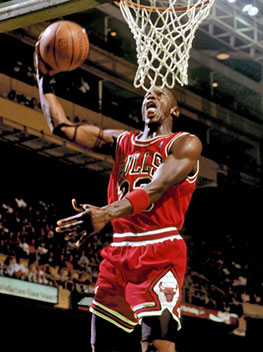

Janet Reno, nominated by President Bill Clinton on February 11 and confirmed on March 11, became the nation’s first female attorney general and the second longest serving attorney general after William Wirt.

The North American Free Trade Agreement (NAFTA) took effect—this was one of the Chamber’s most extensive grassroots communications and lobbying campaigns in its history.

NAFTA immediately eliminated tariffs on more than one-half of U.S. imports from Mexico and more than one-third of U.S. exports to Mexico.
The Chamber published A Guide to the North American Free Trade Agreement, which contained an analysis of the historic agreement.
The Food Quality Protection Act was signed by President Clinton. This act mandated a health-based standard for pesticides used in foods, a move long sought for by the Chamber.
The Chamber launched its first home page on the Internet’s World Wide Web.
This home page at www.uschamber.org was a new resource for information on the business federation.
Thomas J. Donohue, who succeeded retiring President Richard Lesher, became president and CEO of the Chamber.

Donohue expanded the Chamber’s lobbying team, the first step to becoming the most powerful lobbying organization in our nation’s capital.
In announcing the expansion, Donohue said, “The Chamber’s primary mission is to win legislative victories for business on Capitol Hill. We are substantially increasing our presence on Capitol Hill with lobbyists of outstanding skill and breath.”
The Chamber successfully led a broad coalition of businesses and associations in drafting and passing the Y2K Act.
Y2K was a problem for both digital (computer-related) and non-digital documentation and data storage situations which resulted from the practice of abbreviating a four-digit year to two digits.
The Chamber led a complex fight to win congressional approval of Permanent Normal Trade Relations (PNTR) for China, ensuring that our companies, workers, and farmers reap the benefits of the market-opening measures China that were agreed to in a bilateral trade deal in the fall of 1999.
PNTR was the most important vote in Congress in 2000 and the most important free trade vote in a generation.
President George W. Bush signed into law the first major piece of legislation of his presidency, a $1.35 trillion tax cut over 10 years. The Chamber played a major role in this enactment.
This legislation included rate reductions at all income levels and the eventual total repeal of the death tax.
For 102 minutes on September 11, 2001, the world looked on in horror as terrorists flew hijacked passenger planes across American cities.
Ten years later marked the largest day of service in United States history. The Chamber’s BCLC created a 9/11 Day of Service Business Map that featured 9/11 service projects by the business community.
The Chamber endorsed 294 pro-business congressional candidates in the 2002 election cycle. With this support 90% won their elections.
President Bush signed the No Child Left Behind Act (NCLB) into law, which is based on the premise that setting high standards and establishing measurable goals can improve individual outcomes in education.
On October 4, 2006, the Chamber launched a broad-based business coalition in conjunction with the Business Roundtable to sustain and improve No Child Left Behind (NCLB).
Kelly Clarkson, a 20-year-old cocktail waitress from Texas, was the first winner of of American Idol in a live television broadcast from Hollywood’s Kodak Theater.

As of 2011, American Idol was the most watched TV series in the Nielsen ratings and the only program to have been No. 1 for seven consecutive seasons, surpassing All in the Family and The Cosby Show, which were both No. 1 for five consecutive seasons.
The Chamber played a leading role in securing House and Senate passage of free trade agreements (FTAs) with Chile and Singapore.
These FTAs knocked down tariff and nontariff barriers to American manufactured goods, services, and agricultural products.
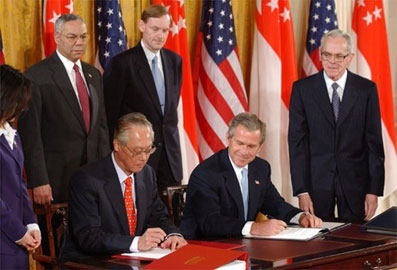
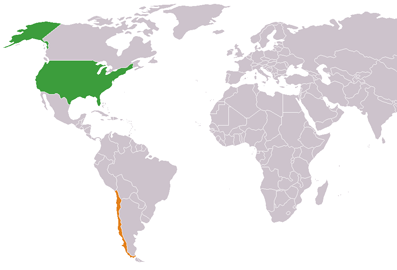
Apple launched iTunes® Music Store, a revolutionary online music store that enables customers to quickly find, purchase, and download music for just 99 cents per song, without subscription fees. iTunes sold 10 million songs within four months.
The Chamber hosted the first major conference, formally called ACCESS, that focused on small business issues. The conference is now called America’s Small Business Summit.
The Summit was a one-day event held at Chamber headquarters, hosting almost 300 small businesses. It is now an annual three-day event held in Washington, D.C. It unites nearly 1,000 small business owners, managers, and entrepreneurs from across the country to learn, network, and discuss common legislative and management concerns.
The Small Business of the Year Award, which honors our nation’s job creators and recognizes their significant contributions as drivers of economic growth, was started in 2007.
The Chamber helped win passage of the U.S.-Dominican Republic-Central America Free Trade Agreement (DR-CAFTA) through aggressive advocacy efforts, including fly-ins and grassroots education programs.
DR-CAFTA spurs economic and social progress throughout Central America and the Caribbean.
In one of the most important foreign policy votes of the decade, the Chamber-led Coalition for Partnership with India (CPI) secured congressional approval of the Henry J. Hyde United States and India Nuclear Cooperation Promotion Act (Hyde Act), thus enabling civilian nuclear cooperation with India.
The Chamber’s U.S.-India Business Council (USIBC) and the broader CPI were instrumental in securing passage of the Hyde Act.

The Institute for a Competitive Workforce (ICW), the Chamber education and workforce nonprofit, nonpartisan, 501(c)3 affiliate, was established. ICW was formerly known as the Center for Workforce Preparation and Quality Education.
The Chamber continued to roll out centers around major programs and initiatives that support top issues for the business community.
In 2007, the three centers that were launched included:
• The Global Intellectual Property Center (GIPC)
• The Center for Capital Markets Competitiveness
(CCMC)
• The Institute for 21st Century Energy

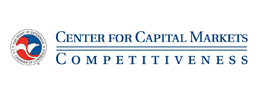

The Chamber launched Friends of the U.S. Chamber, a grassroots program for people who want to make a difference and are committed to ensuring the strength of our economy.
Join our network and add your voice to the national debate on critical issues that impact you and your community.

President Bush addressed the small business audience at the U.S. Chamber’s Small Business Summit praising them for their contributions to the economy.
During his remarks, the president singled out the Chamber and its members for pushing a pro-growth business agenda, including passage of the economic stimulus bill.
Avatar, an American epic science fiction film written and directed by James Cameron, was released. Avatar is the world’s highest grossing film—earning $2,782,275,172 in box office sales!

Sen. Barack Obama (D-IL) was inaugurated 44th president of the United States.

President Obama signed the American Recovery and Reinvestment Act of 2009 into law—a $787 billion package of spending and tax cuts to help shorten the recession, jump-start the economy, and put Americans back to work. The Chamber supported this act.

The Chamber launched The Campaign for Free Enterprise to affirm America’s belief that the values of individual initiative, hard work, freedom of choice, and the free exchange of capital and ideas can lead America back to prosperity.
This comprehensive, multiyear campaign is one of the most important initiatives in Chamber history.
The Chamber launched U.S. Chamber Small Business Nation, a community founded on the open exchange of information and ideas while creating the opportunity for small businesses to speak with a unified voice.
Small businesses account for 75% of all new jobs in this country and 96% of the U.S. Chamber’s membership.

The Chamber’s grassroots network hit a major milestone when it sent 1 million letters to the Hill fighting for policies that promote economic growth and job creation.
The Los Angeles Times called the U.S. Chamber a ‘Political Force.’
“The U.S. Chamber of Commerce is building a large-scale grass-roots political operation that has begun to rival those of the major political parties. … The chamber has signed up some 6 million individuals who are not chamber members and has begun asking them to help with lobbying and, soon, with get-out-the-vote efforts in the upcoming congressional campaigns.” Read the full article.

The Patient Protection and Affordable Care Act was signed into law.
The Chamber’s decade-long advocacy effort for private market-based approaches to health care reform proved unsuccessful. While the Chamber was forced to oppose the overall legislation, its efforts helped eliminate key items that would have negatively impacted the business community including the public option. The Chamber also worked to strengthen positive elements such as the Medicare data sharing provisions. The Chamber continues working on repeal and softening the provisions that harm employers.
For information on how the new health care legislation will affect small businesses in America, visit the U.S. Chamber Small Business Nation’s Health Care key issue page.
President Obama addressed the U.S. Chamber on the joint effort between government and the private sector to spur job growth, innovation, and U.S. competitiveness as a shared responsibility.

The Chamber launched its Hiring Our Heroes program, a yearlong nationwide effort to help veterans and their spouses find meaningful employment.
On Veteran’s Day, First Lady Michelle Obama praised the Hiring Our Heroes program at the U.S. Chamber.
The Chamber hailed the bipartisan Congressional approval of the free trade agreements with South Korea, Colombia, and Panama.
For nearly 10 years, The Chamber intensely lobbied the administration and members of both parties in Congress, mobilized its federation and business activists, and held events that earned positive media coverage across the country.
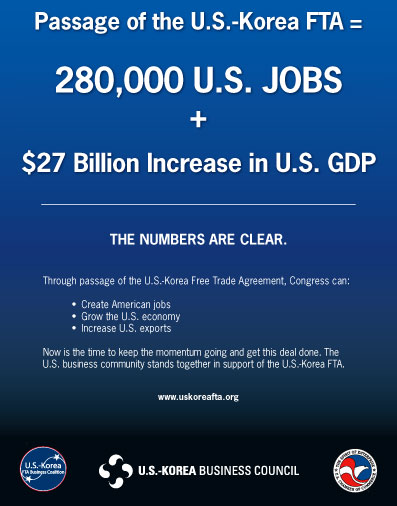
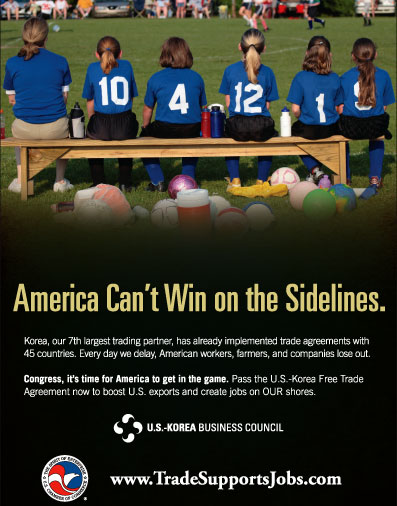
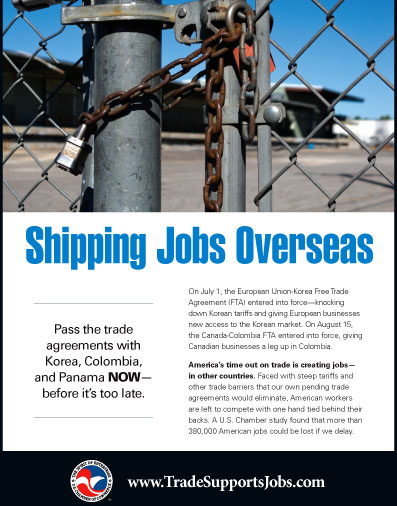

In 2012, the Chamber launched FreeEnterprise.com, a unique, new online portal for the business community. FreeEnterprise.com is your home for free market news and ideas. With opinion pieces, trending information, guest articles, profiles, newsmaker interviews, and video, the site offers more than headlines—it’s a dynamic conversation about American business.
